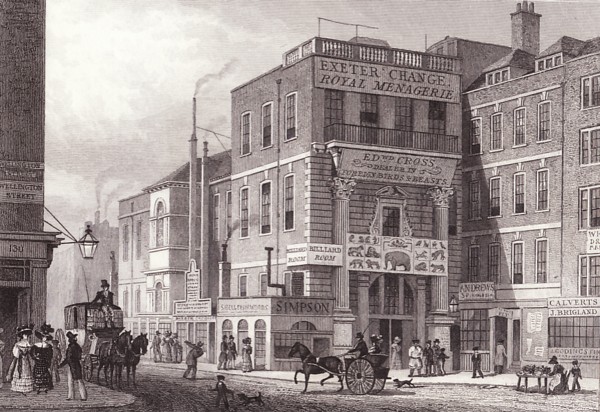Simpson’s-in-the-Strand – In literary, in historical, and in contemporary London
Posted in 1800-1899, 1910-1919, 1920-1929, 19th Century, 20th Century, 21st Century, people, restaurants, Strandlines and tagged with Chartist, Farrell, Literature, restaurant, Sherlock Holmes, Simpson

Why write about this?
Though the website of Simpson’s-in-the-Strand advertises itself as the “Home of Chess,” this is not what drew me to writing about this almost-two-century old restaurant. I was reading a novel by J.G. Farrell, The Singapore Grip, when I stumbled upon the following passage.
“But then, one day in 1925, on a visit to London to see his tailor during his European leave, they had bumped into each other at a restaurant in the Strand, chez Simpson, perhaps?” – The Empire Trilogy, 779. 1
Two months later, while working my way through the incomplete autobiography of Chartist writer John James Bezer, I noticed a print was included in the narrative. 2

Part of the Strand, c. 1825, showing the site of the modern Burleigh House.
The caption of the print, taken from the biography, intrigued me. As I began looking over the details, I saw “Simpson” in capital letters at the bottom. Suddenly, I was reminded of Major Archer’s and Dupigny’s Strand-side dinner from Farrell’s book.
One restaurant, three centuries, past to present. Continuity on the ever-changing Strand. My research into different paintings, prints, and photographs on the restaurant has highlighted one thing. It is a renowned establishment. I simply want to compare three snapshots of this restaurant over three periods.
Blast from the past – 1820s Strand in print:
Firstly, the print from Bezer. In this we actually find an oddity. The caption claims that the print is from circa 1825. Simpson’s own website claim that they have been,
“Serving traditional British fare since 1828.” – Simpson’s In The Strand. 3
Therefore, we can conclude that the print is at least from 1828, if not a little later. It provides a looking glass into an otherwise inaccessible pre-Victorian Strand. There are horse-drawn carriages (reminiscent of the hackney coaches I discussed in another article), well-dressed people around town, children, and even dogs. This is Bezer’s London when he was down on his luck, begging for money to feed his sickly wife and newborn child. 4 Simpson’s well-to-do clientele contrast with the terrible conditions of the large majority of Londoners. This is the Strand in the 1820s.
Roaring twenties – Dinner on the Strand:
Turning to J.G. Farrell’s Simpson, we see two men stumbling into each other in London. Dupigny, a French colonial official, narrates,
“With enormous difficulty they had succeeded in recognizing each other, they had exchanged cards, they had renewed their acquaintanceship.” – The Empire Trilogy, 779. 5
The men, the book, and the restaurant are located in the inter-war years of the British empire. Dupigny is reminiscing on his friendship with Major Archer after the two are reunited in Singapore during the course of the Second World War. The use of “chez Simpson” by the author highlights how famous the restaurant was by the publication of the book in 1978. It must be noted that The Singapore Grip is a fictional book, which criticises the British empire through satire. Around a century after the print included in Bezer’s book, we find two fictional characters dining in the same restaurant.
Not alone – more fictional characters at Simpson’s
“When we have finished at the police-station I think that something nutritious at Simpson’s would not be out of place.” – Sherlock Holmes, The Adventure of the Dying Detective. 6
Sir Arthur Conan Doyle’s celebrated detective was also a patron of Simpson’s in the early 20th century. The Adventure of the Dying Detective was published in 1913. In this story, the two protagonists fast for three days before Holmes proposes a trip to Simpson’s. Seeing as Sherlock Holmes is perhaps one of the most famous literary characters of the period, this is an ideal showcase of Simpson’s notoriety on the Strand. It is also excellent advertising. So good, in fact, that the restaurant itself has a section on their website where they discuss this very passage.
Contemporary London – Future of Simpson’s?
So, where is it now? Currently, due to the ongoing COVID 19 pandemic, the restaurant is closed but they promise to be “back in 2022”. 7 It remains a place out of reach for the majority of Londoners due to its expensive menu. The website specifies a dress code “Smart Casual” for restaurant-goers. Much like the 1820s and the 1920s, this section of the Strand remains a privilege of the ‘lucky few.’ Despite these intrinsic barriers, the restaurant has been a staple of the Strand for close to two centuries. In the wake of all the shops and restaurants who have been forced to close due to financial difficulties in the pandemic, it is somewhat reassuring to know Simpsons will be coming back. Preserving Strand history is what Strandlines is all about.
I hope you enjoy this short journey from the 1820s to the 2020s. Thank you for reading!
- J. G. (James Gordon) Farrell 1935-1979., The Empire Trilogy (New York: New York Review Books, 2005), 779.
- John James Bezer, ‘The Autobiography of One of the Chartist Rebels of 1848’, Minor Victorian Writers, accessed 13 October 2021, https://minorvictorianwriters.org.uk/bezer/b_autobiography.htm.
- ‘Simpson’s in the Strand – Frontpage’, accessed 11 November 2021, https://www.simpsonsinthestrand.co.uk.
- John James Bezer, ‘The Autobiography of One of the Chartist Rebels of 1848’, Minor Victorian Writers, Chapter 9 & 10
- J. G. (James Gordon) Farrell 1935-1979., The Empire Trilogy (New York: New York Review Books, 2005), 779.
- Arthur Conan Doyle, The Adventure of the Dying Detective, His Last Bow (The Project Gutenberg), accessed 11 November 2021, https://www.gutenberg.org/files/2347/2347-h/2347-h.htm.
- ‘Simpson’s in the Strand – Frontpage’, accessed 19 January 2022, https://www.simpsonsinthestrand.co.uk.

My husband took my to Simpson’s in 1982 while on our honeymoon inondon.
We are from Australia & adored our visit. It would be a catastrophe to loose such an institution. Please bring back this amazing restaurant.